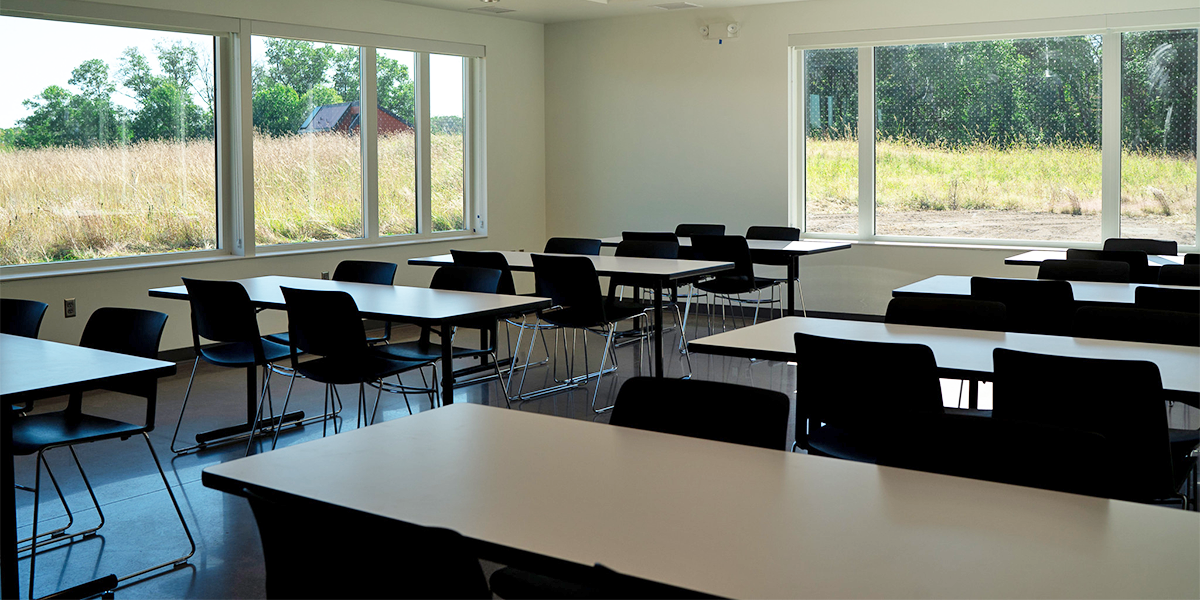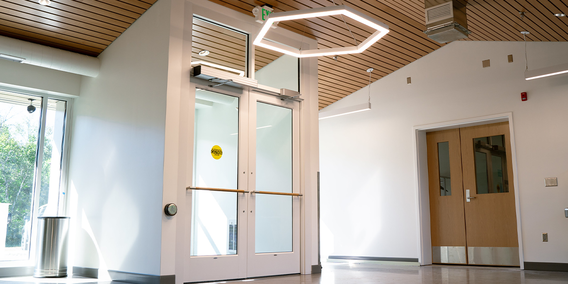
Cedar Creek Ecosystem Science Reserve will begin welcoming students to the Whitney and Elizabeth MacMillan Environmental Learning Center, an addition to the Lindeman Research & Discovery Center, this month. The new space, which includes two new classrooms, will allow Cedar Creek to continue to expand its educational programming for K-12 students and the public. In combination with the new Richard and Judi Huempfner Minnesota Ecology Walk, a .25-mile interpretive trail behind the building, public access to the storied ecological research site has never been greater. Associate Director Caitlin Potter and Education Coordinator Kara Baldwin describe how the new space will be used and what it means for education and community engagement at Cedar Creek.
Cedar Creek has a robust K-12 program. What kind of experiences does your staff offer to students when they visit?
Cedar Creek programming focuses on highlighting the science and scientists of Cedar Creek through authentic experiences that provide hands-on activities that mirror research practices on-site and give students a glimpse into the process of science. While on a field trip, K-12 students can expect to become scientists, working in teams to collect some form of data, analyze the data, and go for a natural history hike or play a game.

What do those activities look like for students who come to Cedar Creek?
Our programs are hands-on and exploratory. For example, students may get in waders and collect aquatic macroinvertebrates at one of our lakes and then identify different species back at the lab. Students may also collect data on the weather, soil, and plant communities to compare different ecosystems or communities. In addition to exploring and seeing science in action, students also get to see beautiful Minnesota ecosystems and habitats through hikes that highlight the deciduous forest, coniferous forest, tallgrass prairies, bogs, and/or oak savannas. Finally, Cedar Creek’s education team works closely with K-12 teachers to create programs that align with their curriculum and learning goals. Cedar Creek provides a unique blend of experiencing Minnesota’s habitats and engaging with meaningful science education.
How have your efforts in this area evolved and expanded over the years?
Our public programs have grown from serving a few hundred students a year in the 1990s and early 2000s to reaching more than 14,000 participants in 2019. We are in the process of re-envisioning and growing our programs after a pandemic hiatus and some staff changes. These new teaching spaces are designed to support this new path forward. In addition to being the home base for our K-12 field trip programs, the new classrooms and wing will be used by undergraduate courses, graduate seminars, summer intern projects, community events (natural history workshops, astronomy star parties, arts programs, etc), and retreat groups. These latter groups are the latest step in an evolution of our public programs, which historically have focused primarily on K-12 student visitors but now reach a much wider audience.

How will the new space support your engagement and outreach efforts?
The new spaces will allow us to better serve our existing clients (hosting multiple groups simultaneously, or hosting more participants from the same group at one time instead of split across multiple days) as well as expand our programs. With the addition of the new wing, we will be able to welcome another 60 students for each field trip, or up to 180 students total each day.
We now have a classroom with a sink and concrete floors so we can explore hydrology, erosion, or water quality and more with students. We also have a new classroom designed for K-3 classrooms with carpeted places to sit, great views of the prairie and woodlands, and easy access to a shorter trail, the Richard and Judi Huempfner Minnesota Ecology Walk, that we can use with younger students. The new building’s entryway provides spaces for art and quiet areas near the teaching spaces for students who may need to step away from their classmates for a few minutes.
Cedar Creek’s existing learning spaces are now more accessible as well, with four new ramps added around the Lindeman and MacMillian Environmental Learning Center buildings. Finally, the addition of a single-stall bathroom with an adult changing table and separate lactation room will improve accessibility and safety by providing a much-needed resource to visitors, staff, and students. –Stephanie Xenos
Cedar Creek Ecosystem Science Reserve is one of two field stations operated by the University of Minnesota’s College of Biological Sciences. Known for long-term ecological research, Cedar Creek has produced major discoveries that have shaped the field of ecology in profound ways.